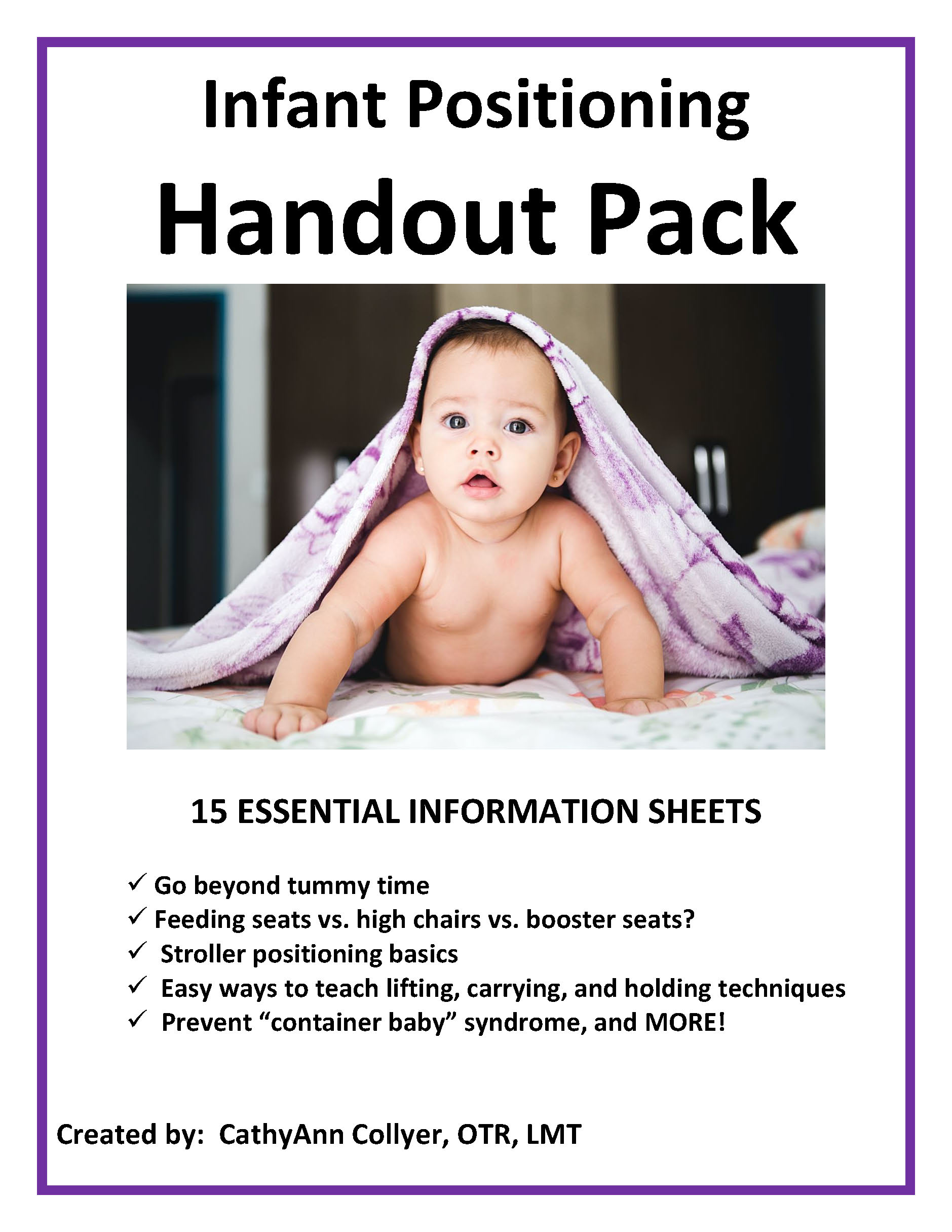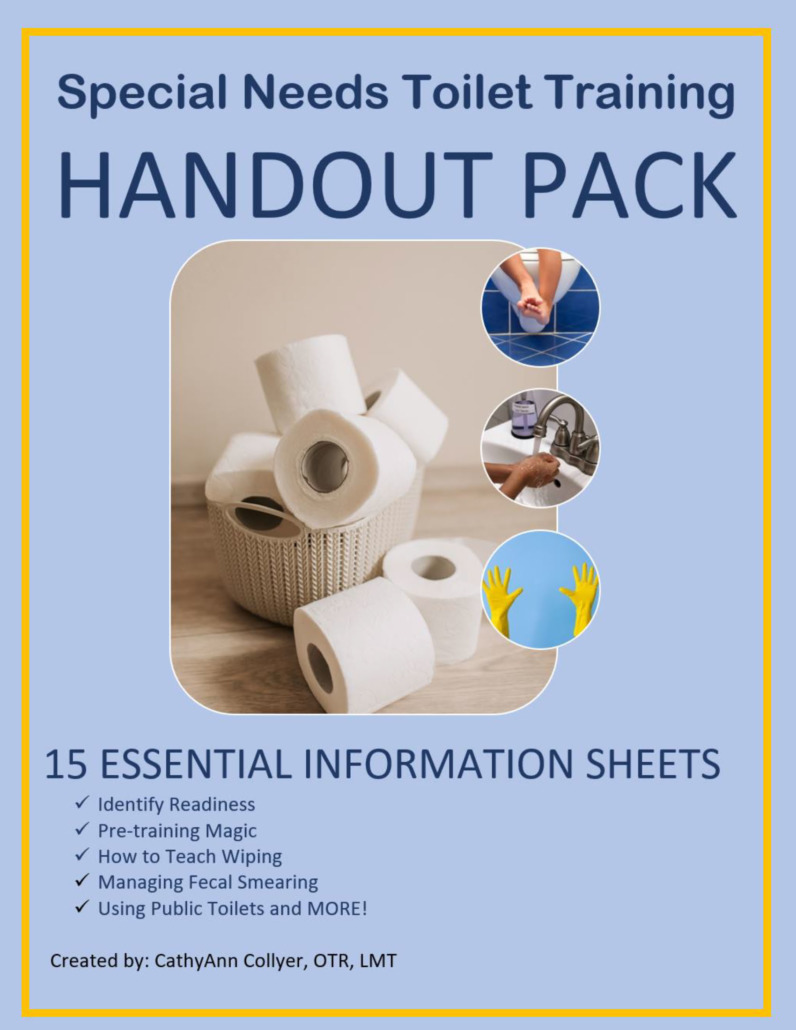Infant Positioning – Mythbusting

There are many myths and misconceptions when it comes to the best way to position your infant especially when it comes to babies with special needs. Let’s bust some of these myths and get the facts straight! Occupational and physical therapists are trained to provide education and information regarding infant positioning for families. You can download a FREE handout at the bottom of this blog post.
This information is from the complete Early Intervention Handouts for Occupational Therapists and Physical Therapist Handout packet. Save hours of time and show your clinical expertise with these ready-to-go handouts for your families from infancy to the toddler stage! It is also included in this bundle.

Early Intervention Occupational Therapy and PT Handouts
MYTH #1: ONCE YOU POSITION YOUR BABY, YOUR JOB IS DONE.
The Truth: Babies and gravity never sleeps. Positioning is an ongoing process that should be revisited frequently throughout the day. A baby’s position should be changed often to provide different experiences and opportunities for development.
Why is this important? When a baby is positioned in the same way for long periods of time, they can become uncomfortable or develop different movement patterns. In addition, babies need to be in different positions to work on their development. For example, tummy time is important for babies to develop the muscles in their necks and shoulders.
MYTH #2: FUSSING MEANS A CHILD IS UNCOMFORTABLE.
Truth: Fussy babies can be bored, lonely, tired, or hungry. Or… all of those things! Automatically assuming that fussing is a sign of discomfort may not be your best choice.
Why is this important? If you attend to your baby based on the assumption that they are uncomfortable, you may be missing an opportunity to figure out what else might be going on. By taking a few moments to observe your baby, you can often figure out what they need.
MYTH #3: HIGH CHAIRS ARE ALL YOU NEED FOR INFANT POSITIONING.
Truth: There are a variety of seating possibilities, and young children may need different seats as they develop. The more complex special needs child is likely to need more than one seat over time.
Why is this important? A high chair is not always the best option for an infant or young child. If a child has low muscle tone, for example, they may benefit from being positioned in an infant seat that gives them more support. As children develop, they often need different types of seats to provide different experiences and opportunities for development.
MYTH #4: GET THOSE FEET ON A FOOTPLATE AS SOON AS POSSIBLE.
Truth: Young infants without the necessary trunk and pelvic control for effective weight shifting can’t use a footplate correctly. They are more likely to use compensatory posturing as a substitute for control.
Why is this important? If a child does not have the necessary trunk and pelvic control, they will not be able to use a footplate correctly. This can lead to compensatory posturing, which can be detrimental to the child’s development.

Special Needs Toilet Training Handouts
MYTH #5: CHILDREN ARE IN STROLLERS FOR SUCH SHORT PERIODS OF TIME THAT POSITIONING DOESN’T MATTER.
Truth: Developmental opportunities occur when infants are out and about as well therefore it is important to make sure they are positioned correctly at all times. Oftentimes, little ones will fall asleep in their strollers so that short period of time can be extended.
Why is this important? Children need to be in appropriate positions at all times to ensure they are getting the most out of their experiences. Strollers provide a great opportunity for infants and young children to explore their surroundings, but if they are not positioned correctly, they may miss out on important opportunities or develop postural asymmetries.
MYTH #6: TUMMY TIME IS PAINFUL FOR INFANTS
Truth: Even babies who have G-tubes can handle tummy time when it is done correctly.
Much of their fussing seen isn’t physical discomfort.
Why is this important? Tummy time is important for infants to develop the muscles in their necks and shoulders. These are early skills that are needed for postural control in sitting, standing, and fine motor skills.
MYTH #7: TUMMY TIME IS ALL YOU NEED FOR DIFFERENT INFANT POSITIONING.
Truth: Side Lying and supine play offer unique benefits that tummy time cannot provide.
Why is this important? Side lying and supine play offer different opportunities for muscle development than tummy time. Gravity influences the body differently when lying on your back, versus your side, versus on your belly. They can help improve trunk control, head control, and eye tracking skills.
MYTH #8: EXPERIENCED PARENTS, BABYSITTERS, AND NANNIES KNOW WHAT TO DO REGARDING INFANT POSITIONING
Truth: Cultural norms and multiple agendas regarding a baby’s daily activities can conflict with optimal positioning.
Why is this important? Just because someone is experienced with children does not mean they are experienced with positioning. Positioning is a specialized skill that requires knowledge of child development and anatomy. It is important to make sure that anyone who is caring for your child is familiar with the importance of proper positioning and how to achieve it.

Cathy Collyer OTR Bundle
MYTH #9: SPECIAL NEEDS INFANTS ALWAYS NEED THERAPEUTIC SEATING
Truth: Many special needs babies can use commercially-available seating, at least when they are younger and for short periods of time.
Why is this important? This is important because it allows for lower-cost options since they may grow out of specialized, expensive, equipment quickly. When infants are positioned properly they can interact with their surroundings and develop important skills.
MYTH #10: INFANT EXERCISERS ARE RISK-FREE ENTERTAINMENT FOR SPECIAL NEEDS BABIES
Truth: Infant exercisers use sling seating, making good posture almost impossible. This is a huge risk for special needs babies.
Why is this important? Special needs babies need to be in proper positions at all times to ensure they are getting the most out of their experiences. Infant exercisers do not provide the necessary support for proper posture and can actually be detrimental to the child’s development.
Talk to your occupational therapist, physical therapist, or physician about the most beneficial infant positioning options for your baby.
DOWNLOAD YOUR FREE INFANT POSITIONING HANDOUT HERE
Would you like a copy of this handout to share with your families? Sign up to receive the email newsletters and announcements from Your Therapy Source. If you are already signed up simply enter your email to access the download. If you do not see the sign up box, click on the blue box in the bottom corner or email us and reference the freebie.



